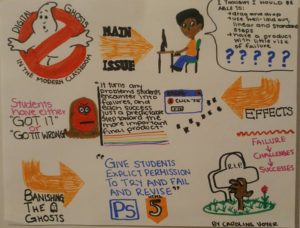Visual Explanation:
The picture attached is a fun way to explain the article “Digital Ghosts in the Modern Classroom” by Ashley Hinck. The illustration starts with a fun ghost busters logo and the first orange arrow (MAIN ISSUE) guides you to Hinck’s central issue about how students are accustom to the simplicity of digital media that allows students to use templates and themes that typically has few errors. This has led students to rely on these platforms, so when they use programs that require coding and the programming presents errors and challenges, the students feel like failures.
The second arrow (EFFECTS) shows how the students get frustrated (as illustrated by the student’s red face). The pictures show bugs and errors presented to the students, and then the student feeling fed-up .
The last arrow (BANISHING THE GHOSTS) is how Hinick suggests we combat these issues. Hinck suggests that we must change the student’s mindsets and approach their failures as challenges and turn them into successes once they have overcome these challenges. This is illustrated by an arm coming out of the graveyard and coming back to life (which is creepy… but represents the student coming back to life, so they are no longer a digital ghost).
Reflection:
I have used many different template websites like Weebly, Wix, Canva… and I have experienced the ease of using these templates to make a visually appealing digital assignment. If I were to create a website or design by myself, I know I would be frustrated and feel like a failure because every time something did not work look beautiful immediately or something did not work I would get frustrated. Knowing this is the way I am as a learner, I will approach digital media for my students as Hinck suggests. I will not take away these sites that allow us to create using templates and themes, but rather help my students to look beyond these platforms and let them experiment without fear of failure to try out different digital platforms. This will increase their comfort, and help them realize that when there are challenges and errors, it does not mean that they have failed.
Enjoy!
Caroline Voyer

